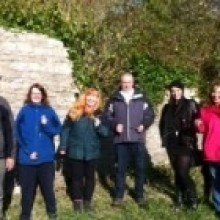We had a fantastic November day today with the sun shining brightly as we met at the very beautiful Pennsylvania Castle on Portland.
John Penn, the grandson of William Penn, founder of Pennsylvania USA, started construction of The Penn in 1797 after King George III gave him the land that it now occupies. He appointed architect James Wyatt, who had designed a number of churches and buildings around England and was well-known for his ‘neo gothic’ style.
The Penn was opened by Princess Elizabeth, daughter of King George III, in 1800 and since then has had a rich and varied history that takes in Royal celebrations (the King and Queen visited in 1800 and enjoyed their wedding anniversary there), the Napoleonic Wars, preparations for the D Day landings, and literary figures such as Thomas Hardy.
At the base of the cliff below Pennsylvania Castle Penn built a large oval shaped bath and in order to use it his servants had to fetch sea water from the cove below. When finished, Portland’s governing Court Leet announced that Penn had built his bath on Common Land and that he would have to pay to use it. They set the price at a then exorbitant 2 shillings and 6 pence per year. Outraged, Penn abandoned his bath (much to the relief of his servants we expect).
In 1950 the castle was turned into a hotel, then back into a private home in 1994 and is once again open to the public for private rentals and celebrations.
A short walk down a wooded path led us to the ruin of St Andrews Church. Built in saxon times and considered to be the oldest church on the Island.
The land at this time stretched a further 1/2 mile out to sea but undersea earthquakes in the late 11 c caused this land to disappear underwater. In time the church became unsafe and of course is now a beautiful and atmospheric ruin.
We did some dowsing here and had a look at some of the very interesting gravestones. I presume that some call it Pirates graveyard because of the skull and crossbones clearly visible on one of the graves.
From here we took a walk across Church Ope Cove where the Portland sea monster Veasta was seen as recently as 2000 – it didnt rear its head for us today though!
Looking down over the cove is Rufus Castle – though to be named after William Rufus son of William the Conquerer – a very rare pectagonal shaped castle imposing on the landscape. William Rufus was thought to be a cruel leader who met his end in mysterious circumstances in the New Forest, where the Rufus Stone can now be seen.
The Portland stone beneath the castle had some huge cracks in it –
Portland stone was used by Sir Christopher Wren to rebuild London after the great fire as it was very soft, easy to carve and pure white, therefore emulating the great cities of Europe.
If you would like to know more about Portland and its history there is an excellent book by Gary Biltcliffe – The Spirit of Portland.
available from https://www.rovingpress.co.uk/Spirit_of_Portland.html
You can also view the show I did for The Light and Energy Channel with Gary based on his book by clicking this link.https://www.thelightandenergychannel.tv/the-spirit-of-portland-with-gary-biltcliffe/


















